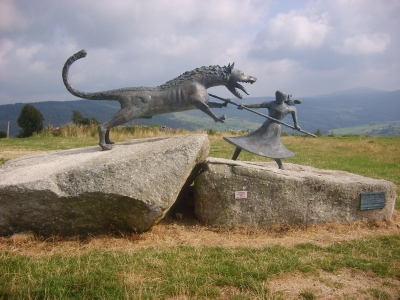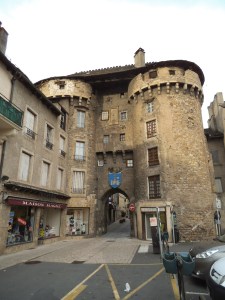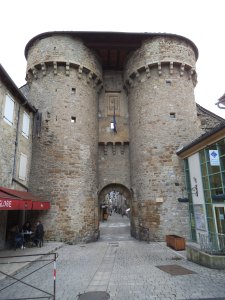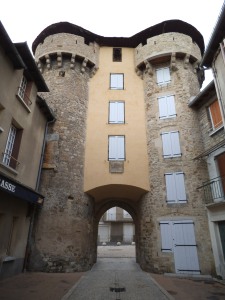 The town of Fontainebleau sits in the middle of a 25,000 hectare forest, former royal hunting ground and now a National Park accessible to all and a popular weekend spot for Parisians. But most people come here to visit the huge royal chateau. In fact, it receives 450,000 visitors each year which is why the car parks in town are extortionately expensive and the restaurants are overpriced.
The town of Fontainebleau sits in the middle of a 25,000 hectare forest, former royal hunting ground and now a National Park accessible to all and a popular weekend spot for Parisians. But most people come here to visit the huge royal chateau. In fact, it receives 450,000 visitors each year which is why the car parks in town are extortionately expensive and the restaurants are overpriced.

 Starting as a small hunting lodge in the 12th century, this residence of the royal family was transformed with each monarch putting his own mark on the place. A total of 34 sovereigns stayed at Fontainebleau, from Louis VI, (1081–1137) to Napoleon III (1808–1873). Treaties were signed there, kings were born and died there, popes and foreign dignities visited (though not always voluntarily) and there was even a murder in the chateau.
Starting as a small hunting lodge in the 12th century, this residence of the royal family was transformed with each monarch putting his own mark on the place. A total of 34 sovereigns stayed at Fontainebleau, from Louis VI, (1081–1137) to Napoleon III (1808–1873). Treaties were signed there, kings were born and died there, popes and foreign dignities visited (though not always voluntarily) and there was even a murder in the chateau.
 Napoleon abdicated in Fontainebleau on 4 April 1814, and two weeks later attempt to commit suicide before being exiled to Saint Helena. However, he still remembered his former home fondly, writing, “It was certainly the most comfortable and happily situated palace in Europe”.
Napoleon abdicated in Fontainebleau on 4 April 1814, and two weeks later attempt to commit suicide before being exiled to Saint Helena. However, he still remembered his former home fondly, writing, “It was certainly the most comfortable and happily situated palace in Europe”.
During the Franco-Prussian War, the palace was occupied by the Prussians and following the First World War, it became home to schools of art and music. It was occupied by the Germans during World War II, and then part of the Chateau became a headquarters of the Allied Forces Central Europe until 1966.

Today it is classified as a UNESCO World Heritage Site, is run by the French government and most of the chateau and grounds are open to the public.
 Despite it being a miserable week, weather wise, the sun is making a brief appearance and so it seems appropriate to start my tour of the chateau with a walk around the gardens. At this time of year they are not particularly colourful but what they lack in lustre, they make up for in sheer size. There is a huge lake, an ornamental area with criss-crossing paths and sculpted yew trees, and a tree-lined canal disappearing off into the distance. Many of the sculptures seem to have been wrapped up for the winter but two weather worn sphinxes guard the start of the canal and a bronze statue of the hunting goddess sits in the centre of the Garden of Diana.
Despite it being a miserable week, weather wise, the sun is making a brief appearance and so it seems appropriate to start my tour of the chateau with a walk around the gardens. At this time of year they are not particularly colourful but what they lack in lustre, they make up for in sheer size. There is a huge lake, an ornamental area with criss-crossing paths and sculpted yew trees, and a tree-lined canal disappearing off into the distance. Many of the sculptures seem to have been wrapped up for the winter but two weather worn sphinxes guard the start of the canal and a bronze statue of the hunting goddess sits in the centre of the Garden of Diana.



On the first Sunday of each month, entrance to the chateau is free so I use the money that I have saved to rent an audio guide and also to book on a guided tour in order to see some of the areas of the chateau which are not open to the general public.
 It takes me 1.5 hours to complete the circuit of the main apartments with my audio guide and that was just listening to the main details for each room. There’s plenty of additional information available if you wish to linger longer. The self-guided tour starts in the Napoleon I Museum which houses clothing (such as his iconic long coat and hat), dinner services, decorative swords and a beautiful cradle for his much-loved son. There is also a long corridor with large family portraits and pure white busts.
It takes me 1.5 hours to complete the circuit of the main apartments with my audio guide and that was just listening to the main details for each room. There’s plenty of additional information available if you wish to linger longer. The self-guided tour starts in the Napoleon I Museum which houses clothing (such as his iconic long coat and hat), dinner services, decorative swords and a beautiful cradle for his much-loved son. There is also a long corridor with large family portraits and pure white busts.


 The papal apartments are so called because it was here that Pope Pius VII stayed in 1804 on his way to the coronation of Napoleon I. He returned in 1812 and stayed for 19 months as an unwilling guest of Napoleon while he unsuccessfully invaded Russia. The apartments are dimly lit to protect the Gobelins tapestries and paintings but they are also richly decorated in papal red and royal gold.
The papal apartments are so called because it was here that Pope Pius VII stayed in 1804 on his way to the coronation of Napoleon I. He returned in 1812 and stayed for 19 months as an unwilling guest of Napoleon while he unsuccessfully invaded Russia. The apartments are dimly lit to protect the Gobelins tapestries and paintings but they are also richly decorated in papal red and royal gold.

 There are two chapels in the chateau; the Saint-Saturnin chapel is a dark, damp shell, with the side windows blocked by additional building of the chateau ballroom and Salle du Tibre wings. The Trinity chapel is much grander with a private balcony for the royal family and beautiful ceiling frescoes. In this chapel Louis XV was married in 1725 and Napoleon II was baptised in 1810.
There are two chapels in the chateau; the Saint-Saturnin chapel is a dark, damp shell, with the side windows blocked by additional building of the chateau ballroom and Salle du Tibre wings. The Trinity chapel is much grander with a private balcony for the royal family and beautiful ceiling frescoes. In this chapel Louis XV was married in 1725 and Napoleon II was baptised in 1810.

 The bedrooms and state rooms are lavishly decorated with patterned cloth and carpets. I particularly like the seat coverings which often depict scenes of wildlife and country living. The queen’s bedroom is so full of patterns that the huge four-poster bed seems almost camouflaged.
The bedrooms and state rooms are lavishly decorated with patterned cloth and carpets. I particularly like the seat coverings which often depict scenes of wildlife and country living. The queen’s bedroom is so full of patterns that the huge four-poster bed seems almost camouflaged.






 Unfortunately, the one area where I would have loved to have wandered freely is roped off. The Diana Gallery is an 80m long corridor was originally built be Henry IV as a place for the Queen to promenade. Its vaulted ceiling was decorated with scenes from the mythical story of Diana, the huntress. When Napoleon I moved in he turned it into a gallery dedicated to the achievements of the Empire but, when the monarchy was restored, Louis XVIII returned it to its former glory. Eventually, in 1853, Napoleon III turned it into a library and I am instinctively drawn to those old books, wanting to feel the leather bindings and discover the words within.
Unfortunately, the one area where I would have loved to have wandered freely is roped off. The Diana Gallery is an 80m long corridor was originally built be Henry IV as a place for the Queen to promenade. Its vaulted ceiling was decorated with scenes from the mythical story of Diana, the huntress. When Napoleon I moved in he turned it into a gallery dedicated to the achievements of the Empire but, when the monarchy was restored, Louis XVIII returned it to its former glory. Eventually, in 1853, Napoleon III turned it into a library and I am instinctively drawn to those old books, wanting to feel the leather bindings and discover the words within.
 There are some areas of the chateau which are not included in the general admission but by taking a guided tour, I am able to enter these special places. It’s a nice small group of eleven and our guide is an enthusiastic lady who speaks quickly to cram in as much information as possible. Unfortunately, it is all in French but I’m lucky enough to understand most of what she is saying, even the little jokes.
There are some areas of the chateau which are not included in the general admission but by taking a guided tour, I am able to enter these special places. It’s a nice small group of eleven and our guide is an enthusiastic lady who speaks quickly to cram in as much information as possible. Unfortunately, it is all in French but I’m lucky enough to understand most of what she is saying, even the little jokes.
 We start in the Chinese Museum which can be visited with a histopad for an extra fee. Security is tight here as in March 2015, thieves broke into the museum and stole 15 of the most valuable pieces. The rooms were decorated by Empress Eugenie in 1867 in order to display her collection of Asian art. The collection includes gifts from the King of Siam, indeed the entrance is flanked by two Siamese palanquins (travelling chairs). Other Chinese items were looted by French soldiers following the destruction of the Old Summer Palace in Beijing 1860. The walls are decorated with black and gold lacquered panels, the ceilings with Buddhist silk screens and shelves hold many pieces of porcelain and jade figures.
We start in the Chinese Museum which can be visited with a histopad for an extra fee. Security is tight here as in March 2015, thieves broke into the museum and stole 15 of the most valuable pieces. The rooms were decorated by Empress Eugenie in 1867 in order to display her collection of Asian art. The collection includes gifts from the King of Siam, indeed the entrance is flanked by two Siamese palanquins (travelling chairs). Other Chinese items were looted by French soldiers following the destruction of the Old Summer Palace in Beijing 1860. The walls are decorated with black and gold lacquered panels, the ceilings with Buddhist silk screens and shelves hold many pieces of porcelain and jade figures.


Next on our private tour are the private apartments of Napoleon and Josephine which seem small and simple compared to the lavish state rooms of the royal family. I’m rather envious of Napoleon’s large, polished, wood writing desk.

 Finally, we arrive at theatre, recently restored to its former glory due to a €10 million donation from government of Abu Dhabi. There was originally a theatre in the Belle-Cheminée wing but it was destroyed by a fire in 1856. However, Napoleon III, decided to build a new theatre in the eastern end of the Louis XIV wing, the design of which was inspired by the theatres at Versailles and the Trianon Palace.
Finally, we arrive at theatre, recently restored to its former glory due to a €10 million donation from government of Abu Dhabi. There was originally a theatre in the Belle-Cheminée wing but it was destroyed by a fire in 1856. However, Napoleon III, decided to build a new theatre in the eastern end of the Louis XIV wing, the design of which was inspired by the theatres at Versailles and the Trianon Palace.
 I’m not the only one who draws a breath as we enter the golden glow of the room. I would love to be here for a concert or play to really experience the atmosphere. However, as the stage equipment was not included in the restoration project it is unlikely that any productions will ever be held here. What a shame.
I’m not the only one who draws a breath as we enter the golden glow of the room. I would love to be here for a concert or play to really experience the atmosphere. However, as the stage equipment was not included in the restoration project it is unlikely that any productions will ever be held here. What a shame.

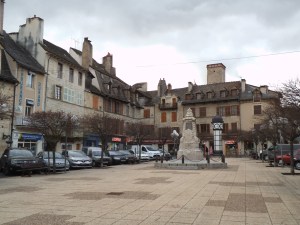 My journey back through France takes me north on the A75 Mediterranean Motorway past many places that I have already visited: Roquefort, Brioude, Issoire and Vichy.
My journey back through France takes me north on the A75 Mediterranean Motorway past many places that I have already visited: Roquefort, Brioude, Issoire and Vichy.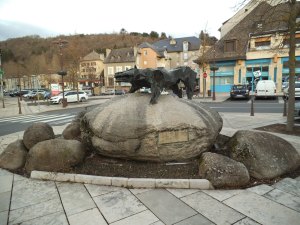 The former province of Gévaudan is synonymous with a terrible tale of the Beast of Gévaudan. Not some mysterious myth but a real story of terror which took place between 1764 and 1767. Research of historical records show that the ‘beast’ may have killed up to 100 people as it hunted throughout an area of about 80 square kilometres. Witnesses who survived attacks described it as being similar to a wolf, but as large as a calf and with red hair. Some people have speculated that it may have been an escaped exotic animal such as a lion or hyena and the attacks do seem similar to man-eating lion accounts from Africa.
The former province of Gévaudan is synonymous with a terrible tale of the Beast of Gévaudan. Not some mysterious myth but a real story of terror which took place between 1764 and 1767. Research of historical records show that the ‘beast’ may have killed up to 100 people as it hunted throughout an area of about 80 square kilometres. Witnesses who survived attacks described it as being similar to a wolf, but as large as a calf and with red hair. Some people have speculated that it may have been an escaped exotic animal such as a lion or hyena and the attacks do seem similar to man-eating lion accounts from Africa. The first recorded attack was of a young woman tending cattle in the Mercoire forest in the summer of 1764 and the first fatal victim took place soon after when 14-year-old Janne Boulet was killed near the village of Les Hubacs. The attacks continued throughout the year, victims being mostly lone men, women and children tending livestock in the forests around Gévaudan.
The first recorded attack was of a young woman tending cattle in the Mercoire forest in the summer of 1764 and the first fatal victim took place soon after when 14-year-old Janne Boulet was killed near the village of Les Hubacs. The attacks continued throughout the year, victims being mostly lone men, women and children tending livestock in the forests around Gévaudan. On January 12, 1765, Jacques Portefaix and some friends were attacked by the Beast but managed to drive it away. Louis XV heard about this and compensated the men, declaring that the French state would help find and kill the beast. Two professional wolf-hunters, Jean Charles Marc Antoine Vaumesle d’Enneval and his son Jean-François, were sent to Gévaudan. They arrived on February 17, 1765, with bloodhounds trained in wolf-hunting. For four months they hunted Eurasian wolves believing them to be the beast but the attacks continued. In June 1765 they were replaced by François Antoine the king’s Lieutenant of the Hunt and on September 20 he killed a very large grey wolf, nicknamed Le Loup de Chazes after the nearby Abbaye des Chazes. The animal was stuffed and sent to Versailles where Antoine was received as a hero and well rewarded. However, the attacks continued.
On January 12, 1765, Jacques Portefaix and some friends were attacked by the Beast but managed to drive it away. Louis XV heard about this and compensated the men, declaring that the French state would help find and kill the beast. Two professional wolf-hunters, Jean Charles Marc Antoine Vaumesle d’Enneval and his son Jean-François, were sent to Gévaudan. They arrived on February 17, 1765, with bloodhounds trained in wolf-hunting. For four months they hunted Eurasian wolves believing them to be the beast but the attacks continued. In June 1765 they were replaced by François Antoine the king’s Lieutenant of the Hunt and on September 20 he killed a very large grey wolf, nicknamed Le Loup de Chazes after the nearby Abbaye des Chazes. The animal was stuffed and sent to Versailles where Antoine was received as a hero and well rewarded. However, the attacks continued. There are no wild wolves in the region today but just north of Mavejols is the Parc Les Loups du Gévaudan, where some 100 wolves from Poland, Siberia, Mongolia, the Arctic and Canada can be visited. There are exhibitions about the Beast of Gévaudan as well as educational displays about wolves to dispel the myth that they are ferocious, deadly animals. Perhaps one day they will be reintroduced to the wild here, as has occurred in other places in Europe.
There are no wild wolves in the region today but just north of Mavejols is the Parc Les Loups du Gévaudan, where some 100 wolves from Poland, Siberia, Mongolia, the Arctic and Canada can be visited. There are exhibitions about the Beast of Gévaudan as well as educational displays about wolves to dispel the myth that they are ferocious, deadly animals. Perhaps one day they will be reintroduced to the wild here, as has occurred in other places in Europe.
